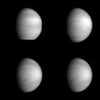Lunar swirls are light-colored, sinuous features on the moon’s surface, bright enough to be visible from a backyard telescope. Some people think they look like the brushstrokes in an abstract painting. But these are not mere artistic flourishes: NASA images show that the tendrils from some lunar swirls extend for hundreds of miles.
Lunar swirls have defied easy explanation, but recent modeling and spacecraft data shed light on the twisty mystery. The data shows that rocks in the swirls are magnetized, and these rocks deflect or redirect solar wind particles that constantly bombard the moon. Nearby rocks take the hit instead. Over time, neighboring rocks become darkened by chemical reactions caused by the collisions, while the swirls remain light colored.
But how did the rocks in lunar swirls get magnetized? The moon does not have a magnetic field today. No astronaut or rover has yet visited a lunar swirl to investigate.
“Impacts could cause these types of magnetic anomalies,” said Michael J. Krawczynski, an associate professor of Earth, environmental and planetary sciences in Arts & Sciences at Washington University in St. Louis. He notes that meteorites regularly deliver iron-rich material to areas on the moon’s surface. “But there are some swirls where we’re just not sure how an impact could create that shape and that size of thing.”
Krawczynski believes it’s more likely that something else has locally magnetized the swirls.
“Another theory is that you have lavas underground, cooling slowly in a magnetic field and creating the magnetic anomaly,” said Krawczynski, who designed experiments to test this explanation. His results are published in the Journal of Geophysical Research: Planets.
Krawczynski and study first author Yuanyuan Liang, who recently earned her Ph.D. in Earth, environmental and planetary sciences in Arts & Sciences, measured the effects of different combinations of atmospheric chemistry and magmatic cooling rates on a mineral called ilmenite to see if they could produce a magnetizing effect.
“Earth rocks are very easily magnetized because they often have tiny bits of magnetite in them, which is a magnetic mineral,” Krawczynski said. “A lot of the terrestrial studies that have focused on things with magnetite are not applicable to the moon, where you don’t have this hyper-magnetic mineral.”
But ilmenite, which is abundant on the moon, can also react and form particles of iron metal, which can be magnetized under the right conditions, Krawczynski and his team found.
“The smaller grains that we were working with seemed to create stronger magnetic fields because the surface area to volume ratio is larger for the smaller grains compared to the larger grains,” Liang said. “With more exposed surface area, it is easier for the smaller grains to undergo the reduction reaction.”
“Our analog experiments showed that at lunar conditions, we could create the magnetizable material that we needed. So, it’s plausible that these swirls are caused by subsurface magma,” said Krawczynski, who is a faculty fellow in the university’s McDonnell Center for the Space Sciences.
Determining the origin of lunar swirls is considered key in understanding what processes have shaped the lunar surface, the history of a magnetic field on the moon and even how the surfaces of planets and moons generally affect the space environment surrounding them.
This study will help interpret data acquired by future missions to the moon, especially those that explore magnetic anomalies on the lunar surface. NASA intends to send a rover to the lunar swirl area known as Reiner Gamma in 2025 as part of the Lunar Vertex mission.
“If you’re going to make magnetic anomalies by the methods that we describe, then the underground magma needs to have high titanium,” Krawczynski said. “We have seen hints of this reaction creating iron metal in lunar meteorites and in lunar samples from Apollo. But all of those samples are surface lava flows, and our study shows cooling underground should significantly enhance these metal-forming reactions.”
For now, his experimental approach is the best way to test predictions about how unseen lava may be driving the magnetic effects of the mysterious lunar swirls.
“If we could just drill down, we could see if this reaction was happening,” Krawczynski said. “That would be great, but it’s not possible yet. Right now, we’re stuck with the surface.”
More information:
Y. Liang et al, Possibility of Lunar Crustal Magmatism Producing Strong Crustal Magnetism, Journal of Geophysical Research: Planets (2024). DOI: 10.1029/2023JE008179
Provided by
Washington University in St. Louis
Citation:
Moon ‘swirls’ could be magnetized by unseen magmas (2024, July 1)



